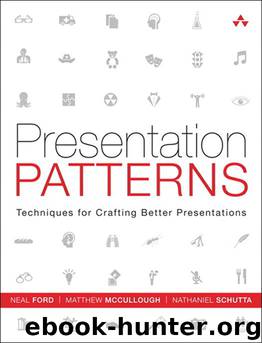Presentation Patterns: Techniques for Crafting Better Presentations by Neal Ford & Matthew McCullough & Nathaniel Schutta

Author:Neal Ford & Matthew McCullough & Nathaniel Schutta
Language: eng
Format: mobi
Publisher: Pearson Education
Published: 2012-08-14T14:00:00+00:00
• covering complex technical subjects; and
• presenting a very abstract, “hand-waving” kind of talk.
On the downside, you must sacrifice some of your presentation time to a metapresentation concern—namely, elucidating the talk’s structure. If you find yourself always using this pattern and your subject area isn’t overly technical, perhaps you should rethink your presentation’s organization. If the attendees can’t figure out the organization, perhaps you should revise the organization to make it clearer. You don’t want the audience to miss your important points because they can’t readily figure out what context a point belongs in. Getting the organization right is sometimes tricky but always improves the clarity of your presentation.
We’ve seen some evil VBA (scripting code for Windows-based applications) code on the Internet that enables you to embed a “live” progress bar in your presentation, showing precisely what percentage you’ve completed. We dislike real-time progress indicators because they distract from your message by introducing too much metapresentation information (see the Going Meta antipattern). You want the audience to proceed within a context of ideas, not just elapsed time. Your audience will start noticing the progress and, just like a user waiting for a document to save, start hoping for a merciful end.
Mechanics
This pattern has many different implementations; a common one is to replicate the agenda slide throughout the presentation. You can use presentation-tool tricks like highlighting the upcoming section or dimming the completed ones à la the Charred Trail pattern.
You don’t have to use bulleted agendas to implement this pattern; it’s difficult to get many levels of indentation unless you resort to Ant Fonts. Neal sometimes uses a mind map to show the overall structure in a single image, as shown in Figure 4.28.
Download
This site does not store any files on its server. We only index and link to content provided by other sites. Please contact the content providers to delete copyright contents if any and email us, we'll remove relevant links or contents immediately.
Nudge - Improving Decisions about Health, Wealth, and Happiness by Thaler Sunstein(7551)
Deep Work by Cal Newport(6856)
Principles: Life and Work by Ray Dalio(6177)
Factfulness: Ten Reasons We're Wrong About the World – and Why Things Are Better Than You Think by Hans Rosling(4675)
The Doodle Revolution by Sunni Brown(4667)
Eat That Frog! by Brian Tracy(4411)
Thinking in Bets by Annie Duke(4140)
Hyperfocus by Chris Bailey(4031)
Visual Intelligence by Amy E. Herman(3710)
Writing Your Dissertation in Fifteen Minutes a Day by Joan Bolker(3660)
Ogilvy on Advertising by David Ogilvy(3485)
How to Win Friends and Influence People in the Digital Age by Dale Carnegie & Associates(3485)
Hidden Persuasion: 33 psychological influence techniques in advertising by Marc Andrews & Matthijs van Leeuwen & Rick van Baaren(3454)
How to win friends and influence people by Dale Carnegie(3382)
The Pixar Touch by David A. Price(3345)
Schaum's Quick Guide to Writing Great Short Stories by Margaret Lucke(3304)
Deep Work: Rules for Focused Success in a Distracted World by Cal Newport(3129)
Work Clean by Dan Charnas(3036)
The Slow Fix: Solve Problems, Work Smarter, and Live Better In a World Addicted to Speed by Carl Honore(2939)
